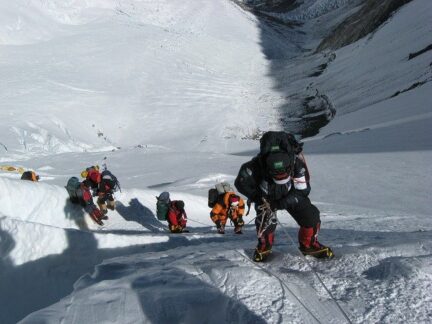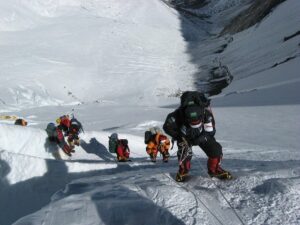Staying at high altitude can cause permanent brain damage


Mountaineers climbing at high altitudes often suffer from altitude sickness, mainly caused by low pressure and hence less oxygen availability. Its symptoms disappear after descending to a lower altitude, but sometimes long-term or even permanent brain dysfunction and damage may occur.
The most common form of altitude sickness is acute mountain sickness (AMS). In non-acclimatized people, it can occur at an altitude of approx. 2500 m above sea level. symptoms include headache and dizziness, feeling exhausted, loss of appetite, nausea and / or vomiting, sleep disturbance, and swelling of the face and limbs. Above 4,500 meters above sea level sometimes visual acuity deteriorates and auditory or visual hallucinations occur. Staying at high altitudes can also lead to other disturbances in the functioning of the nervous system. A decrease in saturation to 85% reduces the ability to concentrate and disturbs muscle coordination. At 75%, the ability to objectively assess events and one’s own conduct is weakened, emotional lability appears and muscle dysfunction worsens.
In advanced cases of altitude sickness, high-altitude pulmonary edema (HAPE) and / or high-altitude cerebral edema (HACE) develop, which often lead to death.
Although altitude sickness passes after descending to lower altitudes, some people returning from high mountains have long-term disturbances in their body functions.
Already in the 1930s it was noticed that people who stayed at high altitudes for a long time without adequate acclimatization could develop permanent brain damage. Reports from later years confirmed these observations. For example, during an expedition to the Himalayas in 1963, six participants spent 4-12 hours above 8,500 meters, and 4 of them ran out of oxygen at the summit. All of them experienced mental and perception problems. They passed after descending to a lower altitude, but long after the expedition, climbers noticed worse memory, difficulties in recalling known names and problems with the choice of words. Some experienced prolonged depressive states.
Zdzisław Ryn called the complex of symptoms caused by brain damage after a stay in conditions of high mountain high-altitude cerebral asthenia.
In the years 1968-1976, Zdzisław Ryn conducted research among Polish participants of high-mountain expeditions. The study involved 40 mountaineers who practiced mountain climbing for 6-25 years and participated in 2-12 alpine expeditions. They stayed from several weeks to several months in the zone of 4000-6000 m in altitude, several weeks at an altitude of 6000-7000 m and from a few to dozen of days above 7000 m. All of them have had an acute mountain sickness at least once.
Participants underwent psychiatric, neurological and psychological examinations before, during and after the expeditions.
Immediately after the expedition, almost everyone experienced slowness, aversion to physical and mental exertion, avoidance of contact with other people, fatigue, excessive sleepiness, difficulty in thinking, memory deterioration, and mood swings. They were irritable, tense, impatient and wanted to return to their country and family as soon as possible. Several climbers reacted differently. Immediately after the expedition, these people were physically and mentally agitated, carefree, made unrealistic plans for the future, felt stunned, easily conflicted and had an increased appetite.
Most of the climbers returned to normal functioning and mental state within a few to several weeks, but in 11 people the symptoms persisted even after 6-12 months, in some even more severe.
In the intellectual sphere, they showed a weakening of the efficiency of thinking and memory, especially remembering, and a narrowing of their interests. They suffered from mental fatigue faster and felt fatigue, for example, while reading or listening to lectures, and had problems with concentration. Two people, being researchers, noticed problems with articulation, which made it difficult for them to conduct classes at the university. They also had to use notes that they did not need before. In the emotional sphere, the respondents’ mood was depressed and their sense of humor weakened. They had a lower tolerance to difficult and conflict situations, and a few people noticed a greater tendency to impulsive reactions, impatience and even aggressive behavior. Eight people had sexual potency disorders, which in 1 person continued for 4 years after the mountain expedition. In 4 people, symptoms of focal brain damage, such as nystagmus, visual field disturbances, EEG abnormalities, were found. A year after the expedition, 1 climber still had paresis of his right arm and left leg, which occurred during his stay at an altitude of 7,700 m.
Climbers whose disturbances lasted for a long time after the expedition made several high mountain expeditions and spent a long time in the zone of extreme altitudes without the use of oxygen. They all also had severe mountain sickness in an advanced stage – with cerebral complications, psychotic disorders, and Cheyne and Stokes breathing (irregular breathing with periodic apnea). They also experienced altitude deterioration as manifested by a sharp decrease in body weight.
Several other scientists also conducted similar studies. For example, Brenda T. Townes and colleagues studied 21 climbers who conquered Mount Everest in 1981. Disorders of learning, memory and verbal expression that occurred in some people turned out to be temporary. They were noticeable 3 days after descending to a lower altitude, but after a year there was no trace of them. However, 13 climbers experienced long-term (still visible after a year) disturbances in eye-hand coordination.
More recent studies using magnetic resonance imaging or computed tomography confirm that exposure to high mountain conditions can lead to permanent brain damage. Most studies were carried out only after the expedition, but there are few better methodologically in which participants had brain imaging studies performed before the expedition and after returning from the mountains.
In one study (Paola et al., 2008) participated 9 mountaineers who were members of expeditions to Mount Everest and K2. They all had at least 10 years of experience in mountain climbing and exceeded 4000 m in the Alps several times a year. One climber climbed both Everest and K2, two climbed one of these peaks, and the others did not reach the summit of any, nor the other mountain because of acute mountain sickness. However, they all exceeded an altitude of 7,500 m and spent at least 15 days above 6,500 m.
The mountaineers underwent neuropsychological tests and MRI examinations 8 weeks before and 8 weeks after their return from the Himalayas and Karakoram. Comparing their brain scans before and after the expedition, they found decreased gray matter density and volume in the left angular gyrus. It is an area of the cerebral cortex responsible for various cognitive functions, including movement planning. It was also observed that even before expeditions to the highest mountains in the world, there were some irregularities in their brains. Compared to the control group, they had a lower white matter density and volume near the motor cortex, which may be a result of their earlier stays at high altitudes.
Kottke et al. (2015) conducted research on 38 mountaineers before, during and after an expedition to the Himlung Himal (7126 m). 15 participants spent the night in Camp 3 at an altitude of 7,050 m and 13 made it to the top. After returning from the mountains, MRI showed a slight decrease in the volume of white matter in the brain, and in 3 people who stayed in camp 3, microchemorrhages in the corpus callosum appeared. These people did not have more severe symptoms of acute mountain sickness than mountaineers, who did not have such changes in the MRI examination, but achieved lower saturation values during their stay at high altitudes. The michemorrhages seen in them after the expedition indicate that they broke the blood-brain barrier and were at high risk of developing high-altitude cerebral edema. It is also possible that the symptoms of cerebral edema were indeed present in them, but due to physical and mental exhaustion, neither they nor their colleagues were able to recognize them.
Still little is known about long-term high mountain disorders, but there is no doubt that some people may develop it. However, more research is needed to assess how high the risk of their occurrence is, what type of brain disorders or damage is most common, who is most at risk, and how to treat them.
References
- Kottke R, Pichler Hefti J, Rummel C, Hauf M, Hefti U, Merz TM (2015) Morphological Brain Changes after Climbing to Extreme Altitudes – A Prospective Cohort Study. PLoS ONE 10(10): e0141097 (text at plos.org)
- Paola M. D., Bozzali M., Fadda L., Musicco M., Sabatini U., Caltagirone C. (2008). Reduced oxygen due to high‐altitude exposure relates to atrophy in motor‐function brain areas. European Journal of Neurology, 15(10), 1050-1057. (text at wiley.com)
- Ryn Z. J. (2015). Góry – Medycyna – Antropologia. Medycyna Praktyczna.
- Sołtysik M., Flakus M., Lubecka B., Pudlo R. (2018). Aktualny stan badań nad zaburzeniami psychicznymi u wspinaczy wysokogórskich. Psychiatria i Psychologia Kliniczna, 18(2), 200–207. (pdf at us.edu.pl).
Author: Maja Kochanowska






Add comment